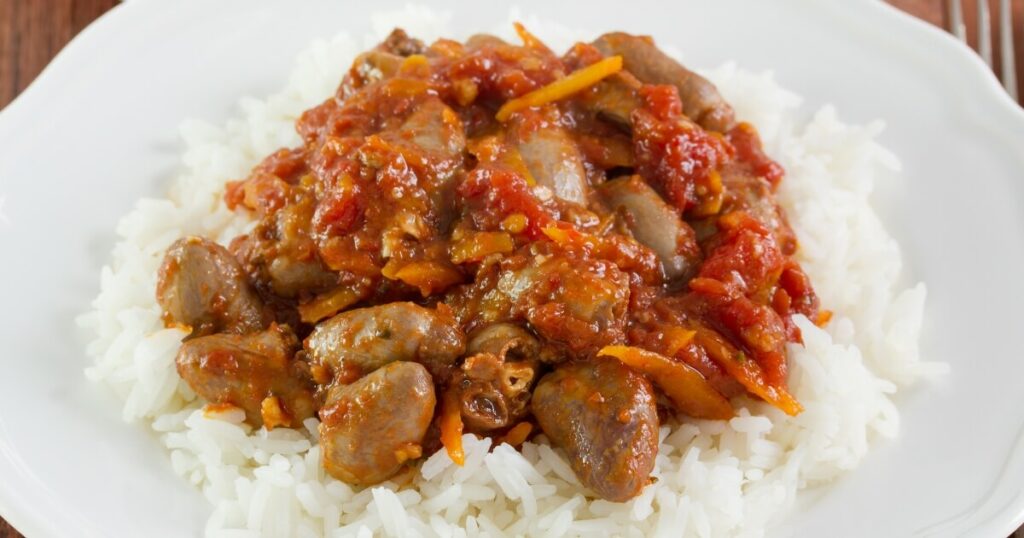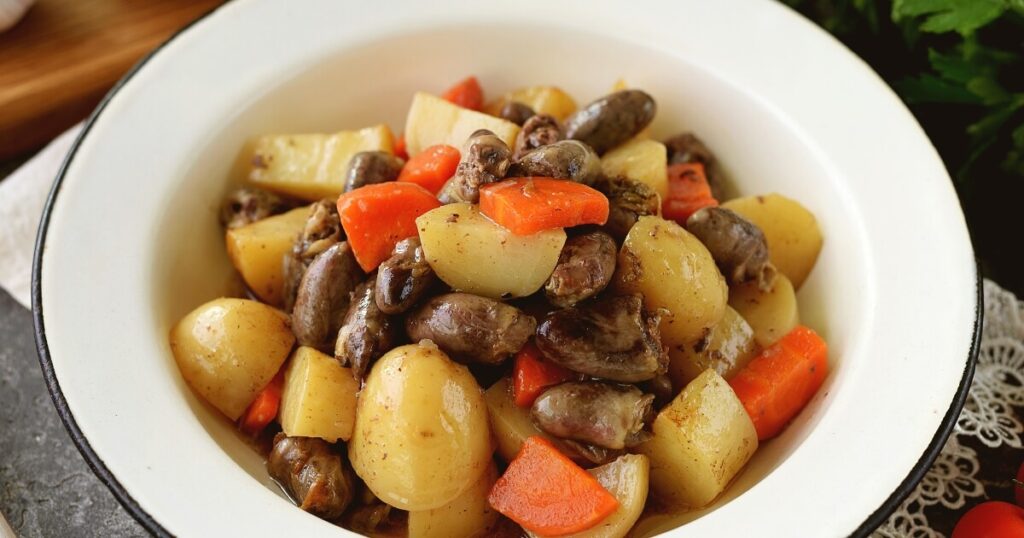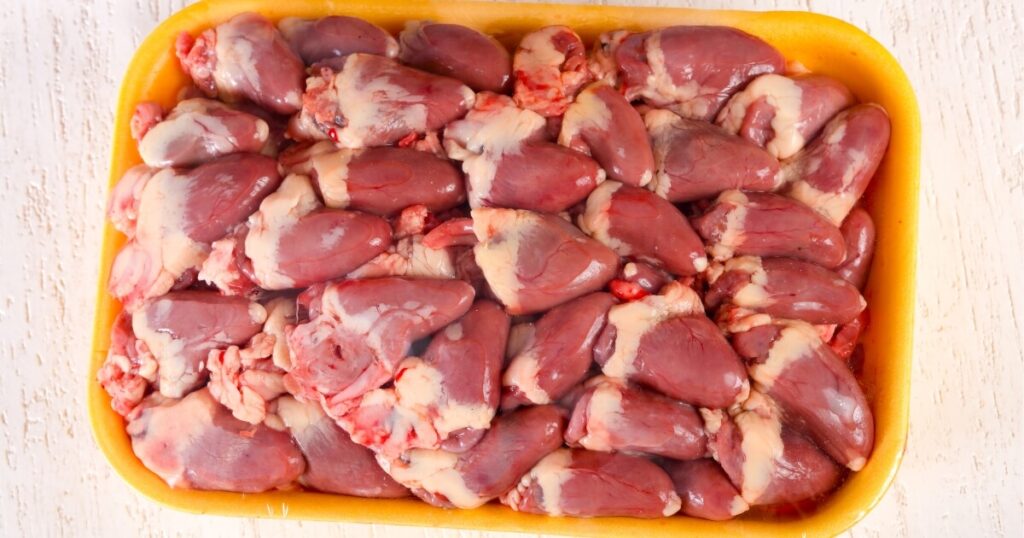Did you know that chicken hearts, despite their small size, are a powerhouse of nutrition? These tiny, cone-shaped organs, often overlooked in mainstream cuisine, are packed with protein, iron, and other essential nutrients.
But their appeal goes beyond their nutritional value. In many cultures worldwide, chicken hearts are eaten for their unique texture and versatility in cooking.
So, if you’re intrigued and ready to learn more, let’s discuss the taste of chicken hearts together. It’s time to spotlight this often-overlooked ingredient and discover what makes it so special.
How Do Chicken Hearts Taste?
The taste of chicken hearts is a delightful blend of chicken liver and dark chicken meat, carrying a slightly sweet undertone with a hint of metallic zing. They offer a rich, meaty flavor that’s enhanced when marinated or seasoned.

Chicken hearts are a carnival of taste sensations. They’re robust like chicken liver yet carry the succulence of dark chicken meat.
A slight sweetness dances on your tongue, coupled with a metallic hint that adds an interesting twist.
The texture is another aspect that sets chicken hearts apart. They’re firm yet tender, almost like a small steak.
When cooked right, they have a satisfying bite to them, not too chewy but with enough substance to make each mouthful enjoyable.
As for the aroma, it’s predominantly meaty, especially when the hearts are grilled or sautéed.

The smell can vary depending on the seasonings used. For instance, marinating them in garlic and herbs lends a savory aroma that’s utterly mouthwatering.
The taste of chicken hearts can vary slightly based on how they’re prepared.
Grilling tends to intensify their meaty flavor while boiling can make them milder. The seasonings used can also play a big role in the final taste.
What Do Chicken Hearts Compare With?
- Chicken Liver: Chicken hearts share a similar rich, meaty flavor to chicken liver. However, they’re less intense and don’t have the same creamy texture.
- Dark Chicken Meat: The taste of chicken hearts is often likened to dark chicken meat, thanks to their robust flavor. But they’re firmer in texture.
- Steak: In terms of texture, chicken hearts can be compared to a small, well-cooked steak. They’re firm yet tender, offering a satisfying bite.
- Gizzards: Chicken hearts and gizzards are organ meats with a similar firm texture. However, hearts are more flavorful and less chewy.
- Duck Hearts: Duck hearts and chicken hearts are quite similar in taste and texture. Both have a rich, meaty flavor, but duck hearts are slightly larger and stronger in taste.
Do Chicken Hearts Taste Good?
Chicken hearts might not be for you if you’re not a fan of organ meats or strong flavors. And the metallic taste, although subtle, can be off-putting.
Chicken hearts have a rich, meaty flavor that’s quite appealing to those who enjoy robust tastes like mine.
How To Make Chicken Hearts Taste Good
- Marinate: Marinating chicken hearts before cooking can enhance their flavor. You can use a simple marinade of olive oil, garlic, and herbs or go for something more complex like soy sauce, ginger, and honey.
- Season Well: Don’t skimp on the seasoning. Salt and pepper are a must. Paprika, cayenne, rosemary, and thyme all work well with chicken hearts.
- Don’t Overcook: Chicken hearts are best when they’re cooked just right. Overcooking can make them tough and chewy. Aim for a firm yet tender texture.
- Grill or Sauté: Grilling and sautéing are excellent cooking methods for chicken hearts. They help to seal in the flavor and give the hearts a nice, slightly crispy exterior.
- Pair with the Right Sides: Chicken hearts can be quite rich, so pairing them with the right sides is important. Fresh salads, roasted vegetables, or a creamy mash can balance out the robust flavor of the hearts.
- Try Different Recipes: There are many delicious recipes out there for chicken hearts. From Brazilian-style grilled hearts to Asian-inspired stir-fries, exploring different recipes can help you find the best way to enjoy this unique ingredient.
How To Eat Chicken Hearts
Here are a few popular methods of preparation that highlight their flavor and texture.
Grilled Chicken Hearts
Grilling is a popular method of cooking chicken hearts, especially in countries like Brazil, where they’re a staple at churrascarias (Brazilian barbecue restaurants).

The hearts are typically marinated in a mix of garlic, olive oil, and herbs, then skewered and grilled over charcoal.
The high heat seals in the flavor and gives the hearts a slightly crispy exterior. They’re often served with a squeeze of fresh lime for an added zing.
Sautéed Chicken Hearts
Sautéing is another great way to prepare chicken hearts. This method allows the hearts to cook quickly, preserving their tender texture. You can sauté them with onions, garlic, and your favorite herbs and spices.
The result is a flavorful dish perfect as a protein-packed snack or a topping for salads and pasta.
Chicken Hearts in Stews

Chicken hearts can also be used in stews. They add a rich, meaty flavor to the broth and hold up well to long cooking times. You can use them in place of or in addition to other meats in your favorite stew recipes.
Fried Chicken Hearts
For a crispy, indulgent treat, try frying chicken hearts. After a quick marinade, coat the hearts in flour or breadcrumbs and fry until golden brown. The result is a crunchy, flavorful bite that’s sure to be a hit at any gathering.
What Do Chicken Hearts Look Like?
Chicken hearts, in their raw form, are small and cone-shaped, about the size of a large cherry. They have a deep, ruby-red color, indicative of their rich iron content. The surface is smooth and glossy, with a firm, dense texture to the touch.

The heart is made up of muscle, so you won’t find any bones or cartilage. However, you might see some fat and veins attached, which are usually trimmed off before cooking.
Inside, the heart is hollow, as it’s essentially a muscular pump.
When cooked, chicken hearts change in appearance. The deep red color turns to a brownish hue, similar to other cooked meats.
Depending on the cooking method, the exterior might take on a charred, crispy look (if grilled) or a glazed, shiny appearance (if sautéed or stewed).
In terms of texture, cooked chicken hearts are firm yet tender. They hold their shape well during cooking, making them ideal for skewering, stir-frying, or adding to stews.
Chicken Hearts FAQs
Are chicken hearts good for you?
Absolutely! Chicken hearts are a nutritional powerhouse. They’re high in protein and a good source of iron. They also contain a range of other nutrients, including zinc, selenium, and B vitamins.
Can you eat chicken hearts raw?
Chicken hearts should not be eaten raw due to the risk of foodborne illnesses. They should always be cooked thoroughly before eating.
Are chicken hearts considered organ meat?
Yes, chicken hearts are considered organ meat, also known as offal. They’re part of the chicken’s cardiovascular system and are classified as muscle meat, similar to other heart meats.


